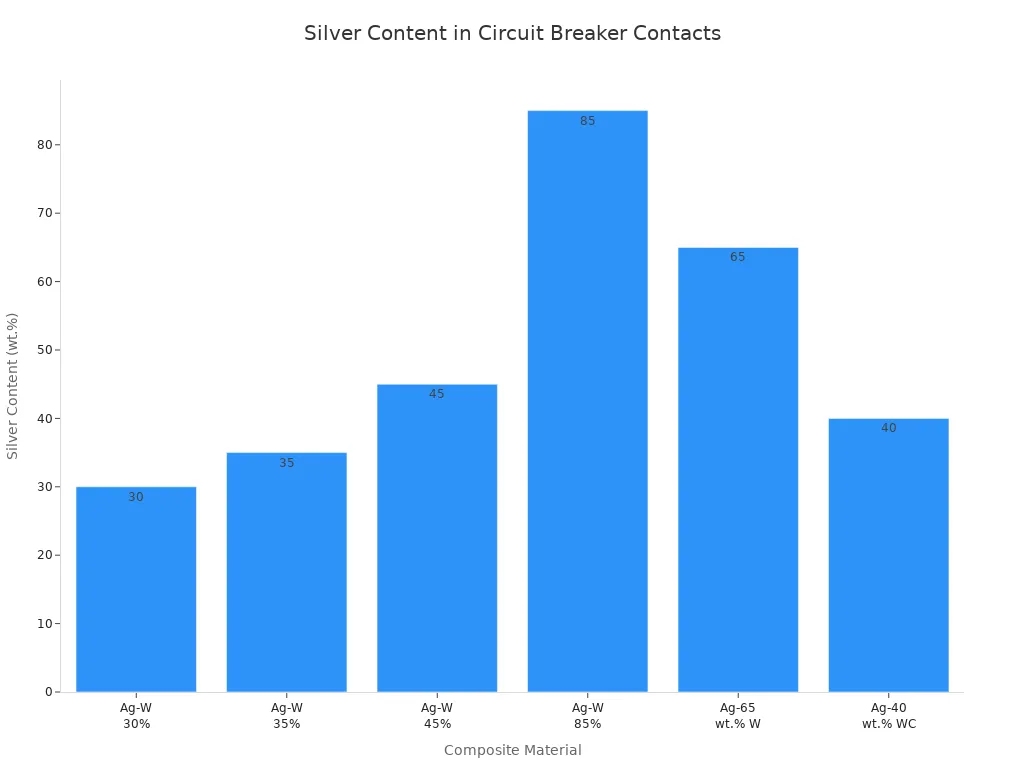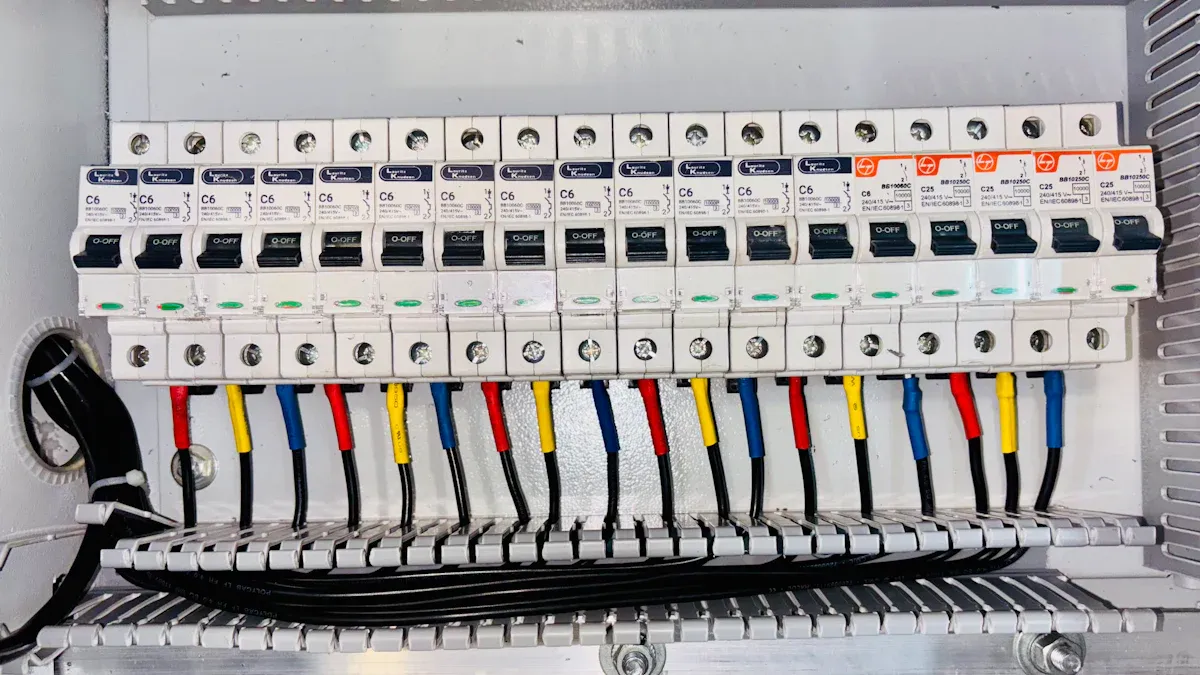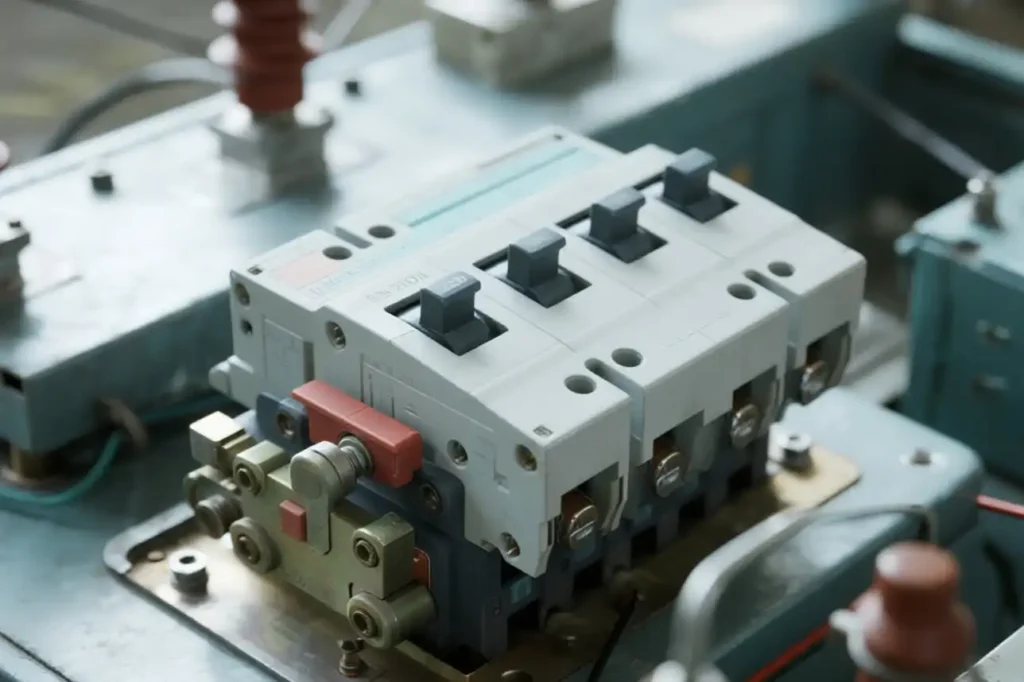Circuit breakers have valuable metals inside. Silver is the most common precious metal found in them. Silver is used because it carries electricity very well. It also does not wear out quickly. Many circuit breakers mix silver with other metals. This makes strong alloys. Older circuit breakers usually have more silver. Newer ones may use less silver or use cheaper materials instead.
Key Takeaways
- Silver is the most valuable metal in circuit breakers. It is mostly found at the contact points. Silver helps carry electricity and stops the parts from wearing out.
- Older and industrial circuit breakers have more silver than new or home models. This makes them better for getting metal back.
- Makers mix silver with metals like nickel and tin oxide. This makes strong alloys that last longer and do not get damaged easily.
- Always be safe when handling circuit breakers. Turn off the power first. Wear safety gear. Do not use dangerous chemicals when taking out metals.
- Clean and sort the metals before selling or recycling them. This can make them worth more. It also helps with better recycling.
Precious Metals in Circuit Breakers
Silver Content
Silver is the main precious metal in most circuit breaker contacts. Manufacturers pick silver because it lets electricity flow very well. This helps circuit breakers work safely and quickly. Silver also moves heat away from the contacts. This keeps the contacts from getting too hot.
Silver oxide still lets electricity pass through. Even if the surface changes, the contact keeps working. This makes silver a good choice for parts that need to last.
The amount of silver in contacts can be very different. Some contacts are made of solid silver. Others use silver alloys or just a silver coating. For example, some companies put a thick layer of silver on copper plates. The thickness depends on the model. Other companies use composite contacts with less silver. These can have 30% to 65% less silver than solid silver. The table below shows how much silver is in different contact materials:
| Composite Material | Silver Content (wt.%) | Application/Notes |
|---|---|---|
| Ag-W | 30%, 35%, 45%, 85% | Used in air circuit breakers; 65% Ag-W widely used |
| Ag-65 wt.% W | 65% | Most widely used in air circuit breakers; balances conductivity and hardness |
| Ag-40 wt.% WC | 40% | Silver-tungsten carbide composite; stable contact resistance |
More silver gives better conductivity but makes the contact softer. Manufacturers try to balance these things. They want the contacts to last and work well.

Alloys and Other Metals
Pure silver is soft and wears out fast if used alone. To fix this, manufacturers mix silver with other metals. This makes alloys that are stronger and last longer. Some common silver alloys in circuit breakers are:
- Silver-Nickel (AgNi): Makes the contact stronger and harder. It also helps stop corrosion and wear.
- Silver-Cadmium Oxide (AgCdO): Stops arc erosion and keeps high conductivity. It is used less now because cadmium is toxic.
- Silver-Tin Oxide (AgSnO₂): Helps stop arcing and welding. It keeps the contact working under stress.
- Silver-Tungsten Carbide (AgWC): Is strong and works well with electricity. It is used in vacuum circuit breakers.
| Alloy Name | Composition | Key Benefits | Common Applications |
|---|---|---|---|
| Silver-Nickel (AgNi) | Silver alloyed with nickel | Adds strength, hardness, wear and corrosion resistance | Electrical contacts, connectors, circuit breakers |
| Silver-Cadmium Oxide (AgCdO) | Silver with cadmium oxide | Excellent arc erosion resistance, high conductivity | High-power and high-voltage circuit breakers |
| Silver-Tin Oxide (AgSnO₂) | Silver combined with tin oxide | Improves arc erosion and welding resistance | High-power switches, circuit breakers |
| Silver-Tin Oxide-Indium Oxide (AgSnO₂In₂O₃) | Silver with tin oxide and indium oxide | Enhanced arc resistance and mechanical properties | Specialized electrical contacts |
| Silver-Tungsten Carbide | Silver with tungsten carbide | High mechanical and electrical performance | Vacuum circuit breakers |
Alloys like AgCdO, AgW, AgMo, and AgWC are made with powder metallurgy. This process makes contacts that are dense and last longer. They also resist damage from electrical arcs.
Other metals like copper, brass, and aluminum are in circuit breakers too. These metals help carry electricity but are not precious metals. They do not have the same value as silver.
Rare Metals
Gold and palladium are sometimes used in electrical contacts. But they are rare in circuit breakers. Manufacturers use these metals only when extra protection from corrosion is needed. Most circuit breakers do not have gold or palladium because they cost a lot. Instead, manufacturers use silver and its alloys for most jobs.
Copper, brass, and aluminum are found in many parts of a circuit breaker. They help with electrical connections but are not worth much for metal recovery. People looking for precious metals should focus on the silver in the contacts.
Metal Locations
Contacts
Silver is found mostly in the contact points. These are inside circuit breakers. The contacts control how electricity moves. They must handle a lot of heat and sparks. Older breakers often have solid silver buttons as contacts. Some brands use square contacts. Others use round ones. High-current models may mix silver with tungsten. This helps the contacts not melt and last longer. Silver contacts are usually joined by brazing. This can leave copper-colored marks. Chemical tests can find silver even if it is mixed with tungsten. Silver is not spread everywhere in the breaker. It is mostly in the contact areas.
- Silver contacts can look like:
- Solid silver buttons, square or round
- Silver alloy pads on copper or brass
- Sintered tungsten with silver for more strength
Tip: In older circuit breakers, look for braided copper wires with silver. These wires help electricity flow better and might have extra silver.
Terminals
Terminals link the circuit breaker to the rest of the system. Most terminals use copper or brass. These metals carry electricity well and cost less than silver. Some terminals have a thin silver layer to stop rust and work better. Not all breakers use silver in their terminals. Many new designs use only copper or aluminum. This is common in the jaws that grip wires. There is usually less silver in terminals than in the main contacts.
Internal Parts
Inside circuit breakers, there are other valuable metals. These include copper, aluminum, and steel. These metals make the frame, springs, and moving arms. Bigger breakers have more metal, so they are worth more as scrap. Precious metals like silver are almost never outside the contacts and terminals. Gold and palladium are almost never in these parts. Most value for metal recovery comes from the contacts. Some value also comes from the terminals.
Types of Circuit Breakers

Older vs. Modern
Older circuit breakers have more silver than new ones. Before the 1990s, companies used solid silver or thick silver alloys in contacts. Some old circuit breakers have up to 97% silver in some parts. This high silver amount made them last longer and work better when used a lot.
Modern circuit breakers use less silver. Now, companies use thin silver coatings or mix silver with other metals. This change saves money and follows new safety rules. Many new breakers use copper or aluminum for some parts. These metals are cheaper but do not carry electricity as well as silver.
Tip: If you want to get silver, look for older circuit breakers. They often have more silver, so they are worth more.
Industrial vs. Consumer
Industrial circuit breakers have more valuable metals than consumer ones. Factories and big buildings need breakers that handle more power. So, companies use bigger contacts and thicker silver alloys. Some industrial breakers use special alloys like silver-tungsten for extra strength.
Consumer circuit breakers are in homes and small offices. They use less silver. These breakers have smaller contacts and thinner coatings. Companies make them for lower power and lower cost. Most consumer breakers use copper or brass for many parts.
| Type | Silver Content | Common Metals Used | Typical Use |
|---|---|---|---|
| Industrial | High | Silver, silver alloys, copper, tungsten | Factories, large buildings |
| Consumer | Low | Silver (thin), copper, brass, aluminum | Homes, small offices |
People who want to get metals should look at industrial circuit breakers. These usually have more silver and other valuable metals.
Value & Extraction
Estimating Value
People can figure out how much silver is in circuit breakers by doing a few things. First, open the circuit breaker by taking off the plastic cover or drilling out the rivets. Next, use pliers to pull out the silver contacts. You might need to bend the metal to get them out. Then, use a magnet to sort out magnetic and non-magnetic parts. Collect any aluminum pieces you find in the terminals. Weigh the silver contacts and check how pure they are. Many old contacts have about 80% silver, which is like coin silver. Multiply the weight of pure silver by the price per troy ounce. For example, in January 2022, silver was $23.16 per troy ounce.
Refineries can test the silver to see how pure it is. They might pay more for very pure silver. Some companies, like Elemetal, pay for silver based on its purity and weight.
Identification Tips
Finding silver contacts and alloys in circuit breakers takes close looking. The table below shows how to tell silver from tungsten:
| Characteristic | Silver Contacts / Alloys | Tungsten Contacts |
|---|---|---|
| Appearance (New) | White or shiny silver | Dark, almost black |
| Appearance (Used) | Tarnish black or blotchy black oxide | Uniform dark black |
| Base Texture | Smooth | Waffle pattern |
| Scratch Test | Shiny silver appears under tarnish | Hard to scratch |
| Tarnish Removal | Black tarnish rubs off | Black color stays |
| Mechanical Property | Softer, bends | Harder, breaks |
| Oxidation Behavior | Turns black after arcs | No similar tarnish |
Silver contacts look shiny or white when they are new. Used ones might have black tarnish, but you can rub it off. Tungsten contacts are harder and have a waffle pattern.
Extraction Methods
To safely get metals, first check what kind of metal is in the contacts. Many new circuit breakers use copper or aluminum instead of silver. Older breakers, especially from the 1960s or 1970s, often have silver contacts with about 80% purity. Always turn off the power before taking out any breaker. Clean the contacts with a soft brush so you do not damage them. It is safer and better to sell contacts to professional refiners or refurbishers. Do not try to melt or process silver at home. Avoid using dangerous chemicals or making harmful fumes.
Tip: Check breakers often and handle them carefully to keep people and valuable metals safe.
Preparing for Sale or Recycling
Cleaning
Cleaning metal contacts the right way makes them worth more. Workers need to take off dirt, oil, and any plastic or insulation. Use a soft brush or cloth to clean the contacts. If there is tough dirt, use a little rubbing alcohol. Clean contacts look shiny and are easier to sort. Taking off all non-metal parts stops problems during recycling.
Tip: Always wear gloves and safety glasses when cleaning metal parts so you do not get hurt.
Sorting
Sorting metals before selling or recycling helps you get more money. It also makes recycling work better. People should split metals into ferrous (magnetic) and non-ferrous (non-magnetic) groups. You can use a magnet for this. Next, sort non-ferrous metals by type, like silver, copper, brass, and aluminum. Take off insulation, plastic, and other things that are not metal. This makes each group worth more.
- Good sorting helps because:
- You can get up to 50% more for copper, 40% more for aluminum, and 30% more for brass.
- Stainless steel can be worth up to 300% more if sorted.
- It lowers costs and keeps out things that should not be there.
- Recycling works better and gives better results.
- It helps make better recycled materials and supports the environment.
Put metals in containers with clear labels. This helps recyclers work faster and safer.
Selling Options
There are many ways to sell or recycle metals you recover. Some buyers want electrical contacts and pay good prices. Local electrical supply stores might buy contacts if they are still good. You can use online sites like eBay or Craigslist, but it takes more work. Electrical contractors sometimes buy used contacts for repairs. Recycling centers take broken or old contacts and get rid of them safely.
Northern Refineries is a trusted company that buys precious metals. They buy silver, gold, platinum, and palladium from electrical contacts. They do not charge refining fees and pay quickly. Sellers need to collect enough metal before sending it in. If items have PCBs, sellers need special papers and must follow EPA and DOT rules. Most of the time, you do not need special paperwork unless there are PCBs.
Silver is the most valuable metal in old industrial circuit breakers. Newer circuit breakers have less silver inside. To get silver, you must find and sort it carefully. You also need to take it out safely. Recycling the right way helps protect the environment. It also saves important resources. People can do better by learning new ways to recover metals. They should follow local rules and ask experts for help with hard steps. Using special guides can help you get more money and help the planet.
FAQ
How can someone tell if a circuit breaker has silver contacts?
Silver contacts often look shiny or white. Used contacts may show black tarnish that rubs off. A scratch test can reveal a bright silver color underneath. Silver contacts feel softer than tungsten or steel.
Are there any safety risks when extracting metals from circuit breakers?
Yes, safety risks exist. Circuit breakers may hold electrical charge. Always disconnect power first. Wear gloves and safety glasses. Some old breakers may contain toxic materials like cadmium or PCBs. Handle all parts with care.
Can people recycle circuit breakers at regular scrap yards?
Most scrap yards accept circuit breakers for metal recycling. Some yards pay more for sorted silver contacts. Not all yards process precious metals, so check first. Specialized recyclers or refineries may offer better prices for silver.
What tools help remove silver contacts from circuit breakers?
Basic tools include screwdrivers, pliers, and a small magnet.
A soft brush helps clean contacts.
Never use power tools on live equipment.
For stubborn parts, use a small file or wire cutters.
See also
How to choose wires for your 220V 15 ampere circuit breaker
What you should know about second-hand circuit breaker demand
What are fuses in electrical systems?
What size of wire is suitable for a 30 ampere circuit breaker
What size of wire is needed for a 30 ampere circuit breaker



